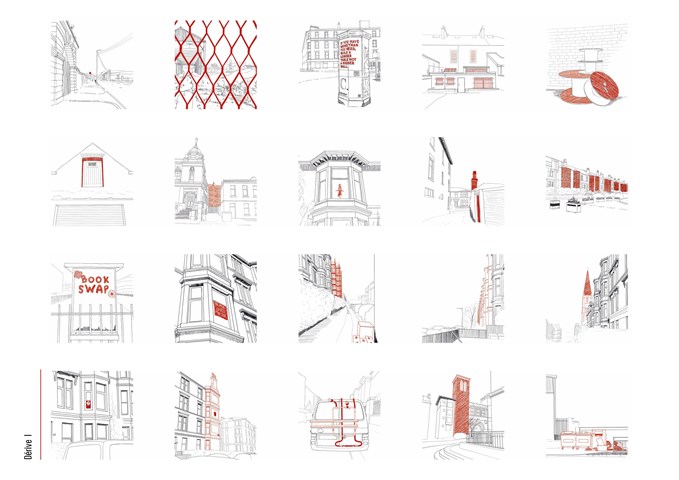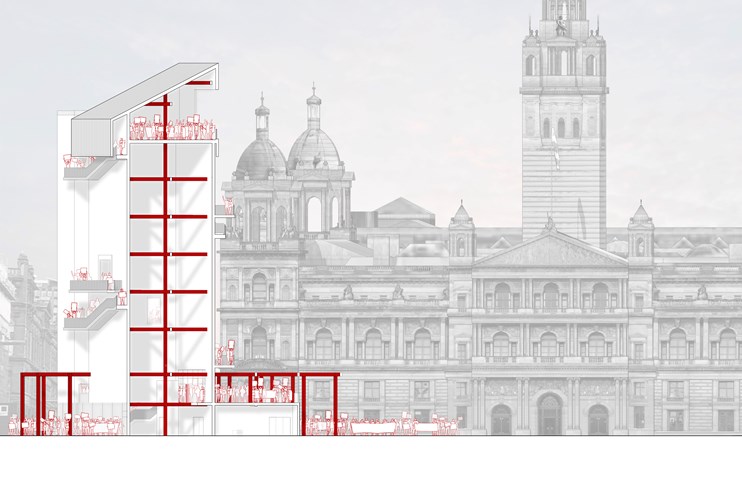Toward an Open City

I am in my final year of study at Strathclyde and will be undertaking my Masters thesis over the summer semester. My fifth year projects adopted a social and political undertone, informed by the likes of: Richard Sennett, David Harvey, the Situationists, and Bernard Tschumi.
Toward an Open City focuses on the multi-faceted relationship between architecture, power, space, and politics. Preceding research on the evolution of the city led to the conclusion that for centuries the city has developed as a reactionary design response to the enemy, forming control mechanisms in cities all over the world. Change on the same scale is required to emancipate the city from this evolutionary trajectory. This study tests theory-driven design interventions in Glasgow, centring on democratic, accessible, spaces within the public realm which encourage citizens to engage with their city and each other. In various locations and scales, through various modes of engagement; they are all designed for free and equal exchange with all of the visceral experience which comes with physical space and proximity.
Adopting principles of accessibility, flexibility, democracy as process, free expression, and citizen ownership; the introduction of three typologies into the city look to deliver programmes of think, discuss, and action. These then form a circular reference, a closed loop forever feeding the next moving the city forward. All of the interventions create points for activity, spontaneity, confrontation, and most importantly exchange, they include:
Arx - A new typology for citizen expression. ACTION.
Pnyx – The reinstatement of an ancient typology for citizen exchange. DISCUSS.
Iter – A common typology reinterpreting boundaries and connection. THINK.

Elements of the Open City
Moving Toward an Open City through design interventions; Arx, Pnyx and Iter. Creating flexible spaces centred on citizen exchange, accepting and celebrating the city as ever evolving and unfinishable. Theory based design interventions tested in Glasgow with scope for deployment in other cities around the world.

Timeline of Designing for the Enemy
The notion of Designing for the Enemy was explored in the first semester of 5th year Design Studies. Thorough exploration into the evolution of the city exposed the reactionary nature of city design; design as an action against the enemy opposed for the citizens.

Glasgow Dérive
From dérive’s, various patterns which draw in the wanderer were noted: Beacon elements that break the skyline, Changes in pattern, material, colour, or texture, Key provocative elements, posters, artworks, activist boards etc., Repetition and rhythm, Layering and depth, Specific elements of intrigue which don’t seem to fit formally or are unexpected.

George Square Arx | During Protest
The design centres on verticality, drawing the users up to be eye to eye with the City Chambers – a very prominent power/political symbol within the city. At this height there is an honesty of position, the citizens can see what is happening in their city, as they ascend, they are offered a panoptic view unhindered.

Arx | Plans and Sketches
The programme and activities of Arx are rooted in citizen ACTION. The current city space which embodies this energy most are its urban squares, symbolic spaces of communication, assembly and expression. Arx looks to embody the meaning of the word, become a fortress for the citizens, a refuge. An entity which can be equally and freely experienced by all users. Illustrated architecturally as a beacon within the city, re-appropriating architectural monuments of power / control / the state, and instead granting it to the citizens.

Pnyx | Sections, Plans and Sketches
The Pnyx are designed to encourage citizens to DISCUSS, enveloping pause points in the city. In Glasgow, these are often formed by green spaces offering the opportunity to slow down or stop for a moment. These spaces grant a particular opportunity for primary and secondary engagement with the programme. The reintroduction of the ancient form which has since been adopted and privatised, also reinstates the identifiable form associated with engagement in the public realm. Accessible to all, allowing citizens to gather together in their common moments.

Iter | Plan and Sketches
Iter looks to surpass boundaries, slow citizens down, allow time and space to THINK and experience others. In Glasgow, it assumes a largely disused railway track which flows through the centre of the city. The focus is on holistic connection, the experience of layering another street or Iter, within the city, and the connection points introduced. It offers a new completely pedestrianised route, removing the intrusion and speed of the car, returning freedom of movement over the speed of movement. It draws people closer together and transcends boundaries whilst utilising acts of compression and connecting different parts of the city similar to Luchtsingel in Rotterdam.

Connectivity of an Open City
Toward an Open City is an important infrastructure though it does not solve all the problems – as there can be no final solution. Through providing a renewed circular programme of interventions which continuously feed each other, it provides new and varied modes of citizen engagement at different scales, in different locations. Ultimately, building a climate which is more open; accepting of the other, adaptable, respectful and understanding.